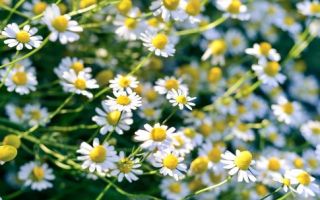Chamomile is a herbaceous annual plant with a branched stem and flowers collected in basket-like inflorescences.
Content
Description and composition
The inflorescences of the basket are used for medicinal purposes. The plant has a characteristic apple aroma. Blooms in July-August. It grows as a weed near homes, along field roads, in fields and poorly cultivated soils.
Baskets are prepared during the period of full flowering. When collecting, it is important not to confuse it with other (non-pharmaceutical) types of chamomile.
Dried flower baskets contain useful substances such as
- essential oil (it contains hydrocarbon, camazulene, terpenes, carpylic and isovaleric acids),
- polysaccharides,
- proteins,
- fats,
- organic acids - nicotinic, salicylic,
- anthemisic acid,
- glycosyl,
- bitter substance
- malic acid salts,
- gum,
- slime,
- vitamins C, B1, B2, K, E,
- carotene,
- Sahara,
- coumarins,
- gum,
- ash,
- macroelements - potassium, calcium, manganese, iron,
- trace elements - magnesium, copper, zinc, cobalt, chromium, aluminum, barium, vanadium, selenium, nickel, strontium, lead, iodine, boron.
Medicinal properties
Chamomile has been used in folk medicine since ancient times. Even Hippocrates, Paracelsus and Avicenna considered medicinal chamomile an effective remedy. Currently, official medicine has its value. This plant is included in the pharmacopoeias of 26 countries, including Russia.
It is widely used as
- anti-inflammatory,
- hemostatic,
- antiseptic,
- painkiller,
- sedative,
- diaphoretic and choleretic agent.
For what diseases is it used?
The effectiveness of chamomile infusion has been proven for diseases such as:
- intestinal spasms,
- diarrhea (orally and in the form of enemas),
- peptic ulcer,
- flatulence,
- candidiasis,
- allergic gastritis and colitis,
- inflammatory diseases of the liver, kidneys, gall and bladder,
- neuralgia.
In addition, modern research has proven that chamomile relieves pain and dilates blood vessels in the brain.
Methods of application
infusion is prepared as follows:
Brew 1 tablespoon of dried chamomile flowers with a glass of boiling water and let it brew until it cools, strain and drink half a glass 3 times a day.
To prepare the decoction you should
Pour one tablespoon of chamomile into a glass of boiling water and simmer over low heat for 5 minutes, then leave for 4 hours and strain. Take 2 tablespoons 4 times a day before meals.
Externally, the infusion is used for sore throat, oral candidiasis, for rinsing, for enemas.
Contraindications
Individual intolerance may be a contraindication. It must be taken into account that it cannot be used for more than 1 month without a break.







